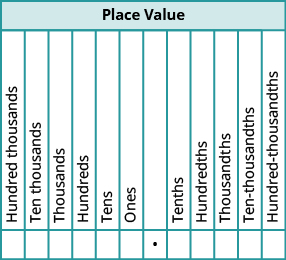
By the end of this section, you will be able to:
A more thorough introduction to the topics covered in this section can be found in the Elementary Algebra chapter, Foundations.
Decimals are another way of writing fractions whose denominators are powers of ten.
Just as in whole numbers, each digit of a decimal corresponds to the place value based on the powers of ten. [link] shows the names of the place values to the left and right of the decimal point.

When we work with decimals, it is often necessary to round the number to the nearest required place value. We summarize the steps for rounding a decimal here.
Round 18.379 to the nearest ⓐ hundredth ⓑ tenth ⓒ whole number.
Round
ⓐ to the nearest hundredth
| Locate the hundredths place with an arrow. |  |
| Underline the digit to the right of the given place value. |
 |
| Because 9 is greater than or equal to 5, add 1 to the 7. |
 |
| Rewrite the number, deleting all digits to the right of the rounding digit. |
 |
| Notice that the deleted digits were NOT replaced with zeros. |
 |
ⓑ to the nearest tenth
| Locate the tenths place with an arrow. |  |
| Underline the digit to the right of the given place value. |
 |
| Because 7 is greater than or equal to 5, add 1 to the 3. |
 |
| Rewrite the number, deleting all digits to the right of the rounding digit. |
 |
| Notice that the deleted digits were NOT replaced with zeros. |
 |
ⓒ to the nearest whole number
| Locate the ones place with an arrow. |  |
| Underline the digit to the right of the given place value. |
 |
| Since 3 is not greater than or equal to 5, do not add 1 to the 8. |
 |
| Rewrite the number, deleting all digits to the right of the rounding digit. |
 |
 |
Round
to the nearest ⓐ hundredth ⓑ tenth ⓒ whole number.
ⓐ
ⓑ
ⓒ 7
Round
to the nearest ⓐ thousandth ⓑ hundredth ⓒ tenth.
ⓐ
ⓑ
ⓒ
To add or subtract decimals, we line up the decimal points. By lining up the decimal points this way, we can add or subtract the corresponding place values. We then add or subtract the numbers as if they were whole numbers and then place the decimal point in the sum.
decimal point in the answer under the decimal points in the given numbers.
Add or subtract: ⓐ
ⓑ
ⓐ* * *
ⓑ* * *
Add or subtract: ⓐ
ⓑ
ⓐ
ⓑ
Add or subtract: ⓐ
ⓑ
ⓐ
ⓑ
When we multiply signed decimals, first we determine the sign of the product and then multiply as if the numbers were both positive. We multiply the numbers temporarily ignoring the decimal point and then count the number of decimal points in the factors and that sum tells us the number of decimal places in the product. Finally, we write the product with the appropriate sign.
the number of decimal places in the factors.
Multiply:
| The signs are different. The product will be negative. |
The product will be negative. |
| Write in vertical format, lining up the numbers on the right. |
 |
| Multiply. |  |
| Add the number of decimal places in the factors (1 + 3). Place the decimal point 4 places from the right. |
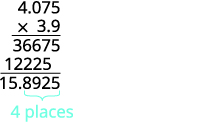 |
 |
|
| The signs are the different, so the product is negative. |
Multiply:
Multiply:
Often, especially in the sciences, you will multiply decimals by powers of 10 (10, 100, 1000, etc). If you multiply a few products on paper, you may notice a pattern relating the number of zeros in the power of 10 to number of decimal places we move the decimal point to the right to get the product.
number of zeros in the power of 10.
Multiply: 5.63 by ⓐ 10 ⓑ 100 ⓒ 1000.
By looking at the number of zeros in the multiple of ten, we see the number of places we need to move the decimal to the right.
ⓐ
| | |  |
{: valign=”top”}| There is 1 zero in 10, so move the decimal point 1 place to the right. | |
|
{: valign=”top”}| There is 1 zero in 10, so move the decimal point 1 place to the right. | |  |
{: valign=”top”}| | |
|
{: valign=”top”}| | |  |
{: valign=”top”}{: .unnumbered .unstyled summary=”Multiply 5.63 by 10. There is 1 zero in 10. So move the decimal point 1 place to the right, to get 56.3.” data-label=””}
|
{: valign=”top”}{: .unnumbered .unstyled summary=”Multiply 5.63 by 10. There is 1 zero in 10. So move the decimal point 1 place to the right, to get 56.3.” data-label=””}
ⓑ
| |  |
{: valign=”top”}| There are 2 zeroes in 100, so move the decimal point 2 places to the right. |
|
{: valign=”top”}| There are 2 zeroes in 100, so move the decimal point 2 places to the right. |  |
{: valign=”top”}| |
|
{: valign=”top”}| |  |
{: valign=”top”}{: .unnumbered .unstyled summary=”Multiply 5.63 by 100. There are 2 zeroes in 100. So move the decimal point 2 places to the right, to get 563.” data-label=””}
|
{: valign=”top”}{: .unnumbered .unstyled summary=”Multiply 5.63 by 100. There are 2 zeroes in 100. So move the decimal point 2 places to the right, to get 563.” data-label=””}
ⓒ
| |  |
{: valign=”top”}| There are 3 zeroes in 1,000, so move the decimal point 3 place to the right. |
|
{: valign=”top”}| There are 3 zeroes in 1,000, so move the decimal point 3 place to the right. |  |
{: valign=”top”}| A zero must be added to the end. |
|
{: valign=”top”}| A zero must be added to the end. |  |
{: valign=”top”}{: .unnumbered .unstyled summary=”Multiply 5.63 by 1000. There are 3 zeroes in 100. So move the decimal point 2 places to the right. A zero must be added to the end to get 5630.” data-label=””}
|
{: valign=”top”}{: .unnumbered .unstyled summary=”Multiply 5.63 by 1000. There are 3 zeroes in 100. So move the decimal point 2 places to the right. A zero must be added to the end to get 5630.” data-label=””}
Multiply 2.58 by ⓐ 10 ⓑ 100 ⓒ 1000.
ⓐ 25.8 ⓑ 258 ⓒ 2,580
Multiply 14.2 by ⓐ 10 ⓑ 100 ⓒ 1000.
ⓐ 142 ⓑ 1,420 ⓒ 14,200
Just as with multiplication, division of signed decimals is very much like dividing whole numbers. We just have to figure out where the decimal point must be placed and the sign of the quotient. When dividing signed decimals, first determine the sign of the quotient and then divide as if the numbers were both positive. Finally, write the quotient with the appropriate sign.
We review the notation and vocabulary for division:
 We’ll write the steps to take when dividing decimals for easy reference.
We’ll write the steps to take when dividing decimals for easy reference.
Divide:
Remember, you can “move” the decimals in the divisor and dividend because of the Equivalent Fractions Property.
 |
|
| The signs are the same. | The quotient is positive. |
| Make the divisor a whole number by “moving” the decimal point all the way to the right. |
|
| “Move” the decimal point in the dividend the same number of places. |
 |
| Divide. Place the decimal point in the quotient above the decimal point in the dividend. |
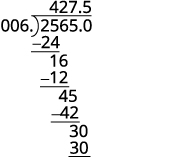 |
| Write the quotient with the appropriate sign. |  |
Divide:
Divide:
In our work, it is often necessary to change the form of a number. We may have to change fractions to decimals or decimals to percent.
We convert decimals into fractions by identifying the place value of the last (farthest right) digit. In the decimal
the 3 is in the hundredths place, so 100 is the denominator of the fraction equivalent to 0.03.
The steps to take to convert a decimal to a fraction are summarized in the procedure box.
Write: ⓐ
as a fraction ⓑ
as a decimal.
ⓐ
 |
|
| Determine the place value of the final digit. |  |
| Write the fraction for 0.374: The numerator is 374. The denominator is 1,000. |
 |
| Simplify the fraction. |  |
| Divide out the common factors. |  |
 |
ⓑ Since a fraction bar means division, we begin by writing the fraction
as
Now divide.
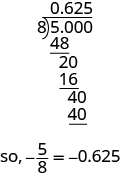
Write: ⓐ
as a fraction ⓑ
as a decimal.
ⓐ
ⓑ
Write: ⓐ
as a fraction ⓑ
as a decimal.
ⓐ
ⓑ
A percent is a ratio whose denominator is 100. Percent means per hundred. We use the percent symbol, %, to show percent. Since a percent is a ratio, it can easily be expressed as a fraction. Percent means per 100, so the denominator of the fraction is 100. We then change the fraction to a decimal by dividing the numerator by the denominator. After doing this many times, you may see the pattern.
To convert a percent number to a decimal number, we move the decimal point two places to the left.
 To convert a decimal to a percent, remember that percent means per hundred. If we change the decimal to a fraction whose denominator is 100, it is easy to change that fraction to a percent. After many conversions, you may recognize the pattern.
To convert a decimal to a percent, remember that percent means per hundred. If we change the decimal to a fraction whose denominator is 100, it is easy to change that fraction to a percent. After many conversions, you may recognize the pattern.
To convert a decimal to a percent, we move the decimal point two places to the right and then add the percent sign.
 <div data-type="note" class="howto" markdown="1">
<div data-type="note" class="howto" markdown="1">
</div>
Convert each:
ⓐ percent to a decimal: 62%, 135%, and 13.7%.
ⓑ decimal to a percent: 0.51, 1.25, and 0.093.
ⓐ
| |  |
{: valign=”top”}| Move the decimal point two places to the left. |
|
{: valign=”top”}| Move the decimal point two places to the left. |  |
{: valign=”top”}{: .unnumbered .unstyled summary=”The given values are 62 percent, 135 percent and 35.7 percent. Moving the decimal point two places to the left in each case, we get 0.62, 1.35 and 0.357.” data-label=””}
|
{: valign=”top”}{: .unnumbered .unstyled summary=”The given values are 62 percent, 135 percent and 35.7 percent. Moving the decimal point two places to the left in each case, we get 0.62, 1.35 and 0.357.” data-label=””}
ⓑ
| |  |
{: valign=”top”}| Move the decimal point two places to the right. |
|
{: valign=”top”}| Move the decimal point two places to the right. |  |
{: valign=”top”}{: .unnumbered .unstyled summary=”The given values are 0.51, 1.25 and 0.093. Moving the decimal point two places to the right in each case, we get 51 percent, 125 percent and 9.3 percent.” data-label=””}
|
{: valign=”top”}{: .unnumbered .unstyled summary=”The given values are 0.51, 1.25 and 0.093. Moving the decimal point two places to the right in each case, we get 51 percent, 125 percent and 9.3 percent.” data-label=””}
Convert each:
ⓐ percent to a decimal: 9%, 87%, and 3.9%.
ⓑ decimal to a percent: 0.17, 1.75, and 0.0825.
ⓐ 0.09, 0.87, 0.039 ⓑ 17%, 175%, 8.25%
Convert each:
ⓐ percent to a decimal: 3%, 91%, and 8.3%.
ⓑ decimal to a percent: 0.41, 2.25, and 0.0925.
ⓐ 0.03, 0.91, 0.083 ⓑ 41%, 225%, 9.25%
Remember that when a number
is multiplied by itself, we write
and read it “
squared.” The result is called the square of a number n. For example,
is read “8 squared” and 64 is called the square of 8. Similarly, 121 is the square of 11 because
is 121. It will be helpful to learn to recognize the perfect square numbers.
If
then m is the square of n.
What about the squares of negative numbers? We know that when the signs of two numbers are the same, their product is positive. So the square of any negative number is also positive.
Because
we say 100 is the square of 10. We also say that 10 is a square root of 100. A number whose square is m is called a square root of a number m.
If
then n is a square root of m.
Notice
also, so
is also a square root of 100. Therefore, both 10 and
are square roots of 100. So, every positive number has two square roots—one positive and one negative. The radical sign,
, denotes the positive square root. The positive square root is called the principal square root. When we use the radical sign that always means we want the principal square root.
is read “the square root of
.”
 If
If
then
for
The square root of m,
is the positive number whose square is m.
We know that every positive number has two square roots and the radical sign indicates the positive one. We write
If we want to find the negative square root of a number, we place a negative in front of the radical sign. For example,
We read
as “the opposite of the principal square root of 10.”
Simplify: ⓐ
ⓑ
ⓒ
ⓐ* * *
ⓑ* * *
ⓒ* * *
Simplify: ⓐ
ⓑ
ⓒ
ⓐ 6 ⓑ 13 ⓒ
Simplify: ⓐ
ⓑ
ⓒ
ⓐ 4 ⓑ 14 ⓒ
We have already described numbers as counting numbers, whole numbers, and integers. What is the difference between these types of numbers? Difference could be confused with subtraction. How about asking how we distinguish between these types of numbers?
What type of numbers would we get if we started with all the integers and then included all the fractions? The numbers we would have form the set of rational numbers. A rational number is a number that can be written as a ratio of two integers.
In general, any decimal that ends after a number of digits (such as 7.3 or
) is a rational number. We can use the place value of the last digit as the denominator when writing the decimal as a fraction. The decimal for
is the number
The bar over the 3 indicates that the number 3 repeats infinitely. Continuously has an important meaning in calculus. The number(s) under the bar is called the repeating block and it repeats continuously.
Since all integers can be written as a fraction whose denominator is 1, the integers (and so also the counting and whole numbers. are rational numbers.
Every rational number can be written both as a ratio of integers
where p and q are integers and
and as a decimal that stops or repeats.
A rational number is a number of the form
where p and q are integers and
Its decimal form stops or repeats.
Are there any decimals that do not stop or repeat? Yes! The number
(the Greek letter pi, pronounced “pie”), which is very important in describing circles, has a decimal form that does not stop or repeat. We use three dots (…) to indicate the decimal does not stop or repeat.
The square root of a number that is not a perfect square is a decimal that does not stop or repeat.
A numbers whose decimal form does not stop or repeat cannot be written as a fraction of integers. We call this an irrational number.
An irrational number is a number that cannot be written as the ratio of two integers.
Its decimal form does not stop and does not repeat.
Let’s summarize a method we can use to determine whether a number is rational or irrational.
If the decimal form of a number
We have seen that all counting numbers are whole numbers, all whole numbers are integers, and all integers are rational numbers. The irrational numbers are numbers whose decimal form does not stop and does not repeat. When we put together the rational numbers and the irrational numbers, we get the set of real numbers.
A real number is a number that is either rational or irrational.
Later in this course we will introduce numbers beyond the real numbers. [link] illustrates how the number sets we’ve used so far fit together.
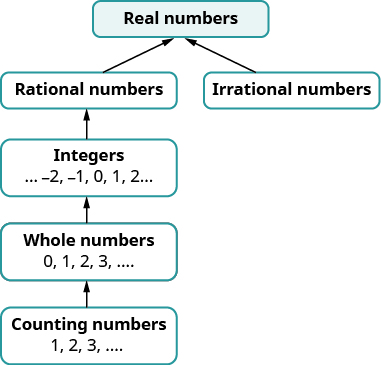
Does the term “real numbers” seem strange to you? Are there any numbers that are not “real,” and, if so, what could they be? Can we simplify
Is there a number whose square is
None of the numbers that we have dealt with so far has a square that is
Why? Any positive number squared is positive. Any negative number squared is positive. So we say there is no real number equal to
The square root of a negative number is not a real number.
Given the numbers
list the ⓐ whole numbers ⓑ integers ⓒ rational numbers ⓓ irrational numbers ⓔ real numbers.
ⓐ Remember, the whole numbers are
so 8 is the only whole number given.
ⓑ The integers are the whole numbers and their opposites (which includes 0). So the whole number 8 is an integer, and
is the opposite of a whole number so it is an integer, too. Also, notice that 64 is the square of 8 so
So the integers are
and
ⓒ Since all integers are rational, then
and
are rational. Rational numbers also include fractions and decimals that repeat or stop, so
and
are rational. So the list of rational numbers is
and
ⓓ Remember that 5 is not a perfect square, so
is irrational.
ⓔ All the numbers listed are real numbers.
Given the numbers
list the ⓐ whole numbers ⓑ integers ⓒ rational numbers* * *
ⓓ irrational numbers ⓔ real numbers.
ⓐ
ⓑ
ⓒ
ⓓ
ⓔ
Given numbers
list the ⓐ whole numbers ⓑ integers ⓒ rational numbers ⓓ irrational numbers ⓔ real numbers.
ⓐ
ⓑ
ⓒ
ⓓ
ⓔ
We now want to include fractions and decimals on the number line. Let’s start with fractions and locate
and
on the number line.
We’ll start with the whole numbers 3 and
because they are the easiest to plot. See [link].
The proper fractions listed are
and
We know the proper fraction
has value less than one and so would be located between 0 and 1. The denominator is 5, so we divide the unit from 0 to 1 into 5 equal parts
We plot
Similarly,
is between 0 and
After dividing the unit into 5 equal parts we plot
Finally, look at the improper fractions
Locating these points may be easier if you change each of them to a mixed number.
[link] shows the number line with all the points plotted.

Locate and label the following on a number line:
and
Locate and plot the integers,
Locate the proper fraction
first. The fraction
is between 0 and 1. Divide the distance between 0 and 1 into four equal parts, then we plot
Similarly plot
Now locate the improper fractions
and
It is easier to plot them if we convert them to mixed numbers and then plot them as described above:

Locate and label the following on a number line:
Locate and label the following on a number line:
Since decimals are forms of fractions, locating decimals on the number line is similar to locating fractions on the number line.
Locate on the number line: ⓐ 0.4 ⓑ
ⓐ The decimal number 0.4 is equivalent to
a proper fraction, so 0.4 is located between 0 and 1. On a number line, divide the interval between 0 and 1 into 10 equal parts. Now label the parts 0.1, 0.2, 0.3, 0.4, 0.5, 0.6, 0.7, 0.8, 0.9, 1.0. We write 0 as 0.0 and 1 as 1.0, so that the numbers are consistently in tenths. Finally, mark 0.4 on the number line.* * *

ⓑ The decimal
is equivalent to
so it is located between 0 and
On a number line, mark off and label the hundredths in the interval between 0 and

Locate on the number line: ⓐ
ⓑ
ⓐ
 ⓑ
ⓑ

Locate on the number line: ⓐ
ⓑ
ⓐ
 ⓑ
ⓑ

Access this online resource for additional instruction and practice with decimals.
is read “the square root of m.”
If
then
for
The square root of m,
is the positive number whose square is m.
If the decimal form of a number

Round Decimals
In the following exercises, round each number to the nearest ⓐ hundredth ⓑ tenth ⓒ whole number.
5.781
ⓐ 5.78 ⓑ 5.8 ⓒ 6
1.638
0.299
ⓐ 0.30 ⓑ 0.3 ⓒ 0
0.697
63.479
ⓐ 63.48 ⓑ 63.5 ⓒ 63
84.281
Add and Subtract Decimals
In the following exercises, add or subtract.
Multiply and Divide Decimals
In the following exercises, multiply.
2.5
55200
In the following exercises, divide. Round money monetary answers to the nearest cent.
Convert Decimals, Fractions and Percents
In the following exercises, write each decimal as a fraction.
1.464
In the following exercises, convert each fraction to a decimal.
In the following exercises, convert each percent to a decimal.
In the following exercises, convert each decimal to a percent.
3
Simplify Expressions with Square Roots
In the following exercises, simplify.
8
12
Identify Integers, Rational Numbers, Irrational Numbers, and Real Numbers
In the following exercises, list the ⓐ whole numbers, ⓑ integers, ⓒ rational numbers, ⓓ irrational numbers, ⓔ real numbers for each set of numbers.
ⓐ
ⓑ
ⓒ
ⓓ
ⓔ
ⓐ none ⓑ
ⓒ
ⓓ none* * *
ⓔ
Locate Fractions and Decimals on the Number Line
In the following exercises, locate the numbers on a number line.
ⓐ
ⓑ
ⓐ
ⓑ
ⓐ
ⓑ
ⓐ
ⓑ
How does knowing about U.S. money help you learn about decimals?
Answers will vary.
When the Szetos sold their home, the selling price was 500% of what they had paid for the house 30 years ago. Explain what 500% means in this context.
In your own words, explain the difference between a rational number and an irrational number.
Answers will vary.
Explain how the sets of numbers (counting, whole, integer, rational, irrationals, reals) are related to each other.
ⓐ Use this checklist to evaluate your mastery of the objectives of this section.
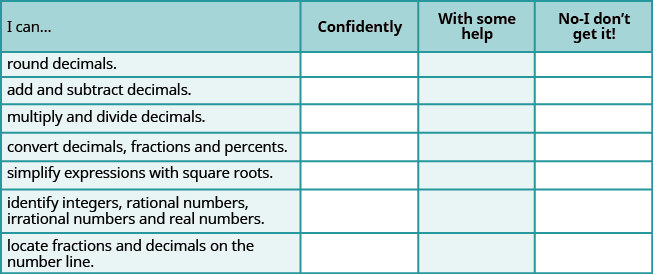 ⓑ On a scale of 1-10, how would you rate your mastery of this section in light of your responses on the checklist? How can you improve this?
ⓑ On a scale of 1-10, how would you rate your mastery of this section in light of your responses on the checklist? How can you improve this?
where p and q are integers and
Its decimal form stops or repeats.
then m is the square of n.
then n is a square root of m.

You can also download for free at http://cnx.org/contents/02776133-d49d-49cb-bfaa-67c7f61b25a1@4.13
Attribution: